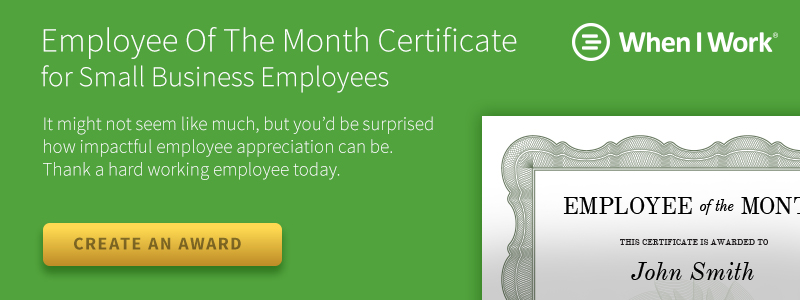A Quick Guide To Effective Employee Engagement
Try When I Work for free
You wouldn’t be a company if you didn’t have employees. And, if you want to be successful in business, you need employees who are effective, engaged, and excited to contribute.
But how can you get your employees engaged? It’s not as simple as throwing a big party and asking employees to get pumped up about their projects. Employees are engaged when they feel fulfilled by their work, are well supported by the company and their team, and feel they are contributing to the company’s goals.
If employees feel like their main job is to grind out work, why would they feel engaged? As a business owner or manager, it’s your job to make them feel at home.
You can prioritize employee engagement by getting everyone on the same page, building a culture that puts employees first, and implementing company-wide programming that has engagement at its core.
Invest in employee scheduling software, you can boost productivity at your organization and use the time you save to grow other areas of your business.
Why does employee engagement matter?
You didn’t hire your employees because they’re great at ping pong. You hired them because they have skills you need to be successful.
But skills are one part of the puzzle. Disengaged employees are expensive—in 2012, Gallup found that low employee engagement could cost the U.S. economy about $370 million every year.
Not only are disengaged employees costing you money, but their counterparts result in higher profits, safer work environments, and increased productivity. Gallup’s study found that engaged employees have 37% lower absenteeism, 48% fewer safety incidents, 21% higher productivity, and 22% higher profitability.
The proof is in the pudding.
Get everyone on the same page
Sure, employee engagement is something you want, but how do you get it?
To improve employee engagement, you need everyone on the same page. You need general agreement that employee engagement is important, which means buy in from leadership and middle management. If the company leaders are not engaged, it will be impossible to spread engagement through the rest of the company.
Even if some aren’t super psyched about spending resources and money improving employee engagement, make sure leaders know about any changes that will be happening. For most initiatives, they should be clued in before their staff.
But being on the same page is about more than getting employee engagement initiatives through—it also means making sure that everyone at the company understands the values and the culture that you’re trying to build. It means that people are aware of company goals.
You don’t need to change your entire business model to facilitate awareness—even monthly and quarterly emails can do a lot to clue people in. Just make sure they’re well-written, as transparent as possible, and interesting to read.
There are two main steps to effective employee engagement:
Step 1– Build a culture that prioritizes employees.
Step 2– Implement company-wide programming that reflects the culture.
Step 1. Build a culture that prioritizes employees
Your company culture needs to prioritize employees—there’s no other way to get effective employee engagement. Here’s how:
Create values, and live by them
“Do as I say, not as I do” is a maxim that never works well on children. Well, it doesn’t work well on employees either.
You can’t just tell employees to be engaged. Instead, you need to create a culture where the status quo is engagement, and you can do that by creating a company mission and set of core values.
For example, FreshBooks uses the acronym PORCHFEST as a shorthand to describe its values to employees—these values are Passion, Ownership, Results, Change, Honesty, Fun, Empathy, Striving, and Trust.
Countless employees have core values like FreshBooks does, and these values not only help employees understand expectations, but they also help hiring managers make better choices.
These core values function as standards for hiring. If a prospective candidate can’t live and breathe the company values, then they’re probably not worth hiring.
Give good and fair benefits
People work because it’s fulfilling, but they also work to provide for themselves and their families. They care deeply about how much money they make, what benefits they get, and how flexible their work environment is.
It’s in your best interest to provide good and fair benefits to employees. Good benefits increase employee retention, which in turn saves you money.
If you don’t have a major budget, think of creative ways to offer benefits. Maybe you can’t offer the world’s most competitive salaries, but you can offer equity. Maybe you can’t offer health insurance that covers everything, but you can get creative by offering HSA or FSA accounts.
Invest in professional development
There’s a famous saying about investing in employees: an executive says “why should we invest in our employees? what if they leave?.” Another employee looks right at him and says “what if we don’t, and they stay?”
The point? Investing in professional development is good for your employees—and for the business.
Conferences, online courses, master’s degrees—opportunities abound on and offline for further learning and professional development. There are online courses on leadership, marketing, and business development for reasonable prices. Intelligent.ly offers leadership courses, while General Assembly and Udemy offer courses of all kinds.
Larger conferences are more expensive, but they’re also a great way for employees to learn.
Reward for good work
When employees work hard and get results, recognize them for it. It’s easy for employees to lose motivation if they’re not getting any benefit from working hard. Why be engaged if the company doesn’t show its appreciation?
Company-wide recognition and awards are important, as are raises and promotions. Make sure you have quarterly meetings to assess performance. Simple things like an employee of the month certificate and office high-fives go a long way, as do company-wide emails highlighting accomplishments.
Be careful not to play favorites—constant recognition of one employee over and over again can frustrate employees, too.
Step 2. Implement company-wide programming
Once you’ve built a company culture that prioritizes employees, you need to implement company-wide programming that ensures your core values are followed. Here’s how:
Company events and outings
Company events and outings have been around forever, but there’s more to it than hosting a holiday party where everyone drinks a lot. Employees need to kick back and have fun, but they also need to feel they serve a greater purpose.
You need a healthy mix of professional events (such as monthly lunch and learns, and quarterly meetings), organized social events (such as go-kart racing, boat cruises, cocktail parties), and charity events (such as 5k races, charity walks, and other volunteer events).
Bringing people together for shared activities will help everyone get on the same page, and allow them to interact in ways that differ from their day to day routine.
Gifts for new hires and major events
Gifts are a thoughtful way to express your appreciation and excitement. That’s why hiring managers honor new hires with personal gifts. After you’ve made a hire, send a thoughtful gift to their home before they start. This will make them feel welcome and excited before they even step through the office doors.
Send gifts when major life events occur, too. If someone buys a house, gets married, has a child, finishes a degree program, or gets terribly sick, make sure to send something their way. It doesn’t have to be big—it’s the thought that counts.
If you’re unsure what gifts to give, Small Business Trends put together a great list of clever employee gifts that can be used year-round.
Employee-to-employee recognition
Employee-to-employee recognition programs take employee engagement out of the hands of leadership, and drop it in the lap of the employees.
Zappos is famous for their employee-to-employee recognition programs—they have four of them! Employees can nominate colleagues for covered parking spots (it’s hot in Vegas) by writing up a story of how they helped out. They can earn zollars, a Zappos currency, by volunteering to help out.
Come up with a creative way to encourage employees to recognize each other. Prizes don’t hurt!
Employee scheduling software
Using employee scheduling software is another way you can boost employee engagement. Give your team 24/7 access to the schedule where they can make time-off requests as they come up, swap and drop shifts to handle those unexpected events, and communicate with each other to get the job done more effectively. Employees that feel a sense of ownership over their schedules are happier and more productive.
Employee engagement matters
You’re a great manager, but you can’t get employee engagement by yourself.
Creating effective employee engagement is no easy task, but ultimately, it will save the business money and make your company a great place to work.
Let your employees’ personalities shine—and give them opportunities for growth.
If you follow the advice in this guide, you’ll be well on your way to improving employee engagement at your organization.







